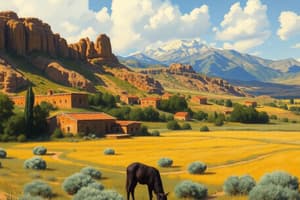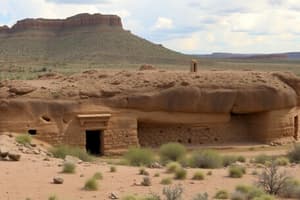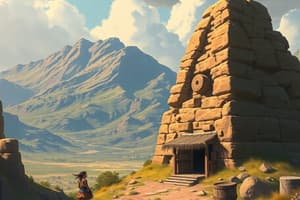Podcast
Questions and Answers
What did the Anasazi and Hohokam people eat?
What did the Anasazi and Hohokam people eat?
Beans, squash, and corn
What was unique about the Anasazi and Hohokam people's architecture?
What was unique about the Anasazi and Hohokam people's architecture?
They built apartments out of mud cliffs on mountains
What was the primary food source of the Mississippi Mound Builders?
What was the primary food source of the Mississippi Mound Builders?
Corn
What was the downfall of the Mississippi Mound Builders?
What was the downfall of the Mississippi Mound Builders?
What was the Olmec civilization known for?
What was the Olmec civilization known for?
What was the significance of the granite heads along the coast in Olmec civilization?
What was the significance of the granite heads along the coast in Olmec civilization?
What was the Maya civilization known for?
What was the Maya civilization known for?
What was the Aztec civilization known for?
What was the Aztec civilization known for?
What was the significance of the city of Tenochtitlan in Aztec civilization?
What was the significance of the city of Tenochtitlan in Aztec civilization?
What was the Inca civilization known for?
What was the Inca civilization known for?
Who was Leif Ericson and what was his significance?
Who was Leif Ericson and what was his significance?
What was the Commercial Revolution and when did it occur?
What was the Commercial Revolution and when did it occur?
Who was Prince Henry the Navigator and what was his significance?
Who was Prince Henry the Navigator and what was his significance?
Who was Vasco de Gama and what was his significance?
Who was Vasco de Gama and what was his significance?
Who was Cabral and what was his significance?
Who was Cabral and what was his significance?
Who was Christopher Columbus and what was his significance?
Who was Christopher Columbus and what was his significance?
Who was Amerigo Vespucci and what was his significance?
Who was Amerigo Vespucci and what was his significance?
Who was Martin Waldseemuller and what was his significance?
Who was Martin Waldseemuller and what was his significance?
What was the Treaty of Tordesillas and what was its significance?
What was the Treaty of Tordesillas and what was its significance?
Study Notes
Anasazi and Hohokam
- Known for the "3 sisters" agricultural method: beans, squash, and corn.
- Constructed apartments integrated into mud cliffs and mountains.
- Held a unique belief system combining polytheism and the worship of a singular god with golden attributes.
Mississippi Mound Builder
- Developed planned cities with a central temple, particularly near present-day St. Louis.
- Constructed mounds for religious and ceremonial purposes.
- Primarily cultivated corn and employed slash-and-burn agricultural techniques which led to environmental degradation, contributing to their decline.
Olmec
- Referred to as the "Egyptians of the West" due to their advanced civilization.
- Practiced polytheism and believed rulers were divine descendants.
- Developed an accurate calendar, skilled in astronomy, mathematics, and writing through hieroglyphics.
- Created recreational games, built large pyramids, and featured granite massive heads along the coast, possibly indicating contact with Egyptians.
- Believed in bloodletting rituals to sustain society.
Maya
- Emerged as successors to the Olmec civilization, covering areas down to Costa Rica.
- Never unified into a single political entity, maintaining independent city-states.
- Developed the concept of zero, created three calendar systems, and wrote in hieroglyphics.
- Similar to Olmec in pyramid construction; civilization faced destruction due to Spanish conquest.
Aztec
- Known as the empire located in central Mexico, with the capital city Tenochtitlan built on an island.
- Large population of approximately 250,000 people, skilled in aqua farming with floating gardens.
- Followed a militaristic approach and practiced human sacrifice for strength.
- Believed in the return of Quetzalcoatl, a god previously banished, who they anticipated would reclaim his land, leading to land offerings.
Inca
- Spanned from Colombia to Argentina and Chile, ruled by a god-king.
- Valued ancestor worship and practiced human sacrifice, especially of children.
- Managed an empire situated at high altitudes, with advanced road systems connecting regions.
- Utilized a labor system known as Mita, assigning specific jobs to individuals, and developed a three-tiered binary language.
- Engaged in a vertical economy, trading goods across mountainous terrains, later conquered by Spanish conquistadors.
Leif Ericson
- Established a settlement in Vinland (present-day Newfoundland) and interacted with indigenous people labeled Skrellings.
- His accidental discovery of North America resulted in a 20-year stay in the region.
Commercial Revolution
- Europe aimed to expand trade between the 1200s and 1400s, seeking goods like silk, spices, and knowledge from the Middle East and Far East.
- European nations sought to bypass Muslim traders to obtain goods directly from Eastern sources.
Prince Henry the Navigator
- Pioneered navigation for trade routes as a Portuguese prince.
- Innovated maritime technology, including advanced boats equipped with cannons.
- Played a vital role in improving navigation tools like the astrolabe and contributed to cartography.
Vasco de Gama
- In 1499, successfully traced Bartolomeu Dias' route around Africa to reach the Orient.
Cabral
- In 1500, diverted from Dias' planned route and unintentionally discovered South America, claiming Brazil for Portugal.
Christopher Columbus
- Aimed to reach China but instead landed in the Americas, mistakenly believing he had reached the East Indies.
- Conducted five voyages to America, misrepresenting the discoveries as encounters with China, and notably perpetrated violence in Cuba.
Amerigo Vespucci
- In 1501, explored from North Carolina to Brazil, publishing "New World" to clarify that he had not discovered China but recognized two new continents.
Martin Waldseemüller
- Produced a significant map in 1507 that incorporated Vespucci's insights and named the two new continents North America and South America.
Pope Alexander VI
- Issued a decree in 1494 to divide trade routes between Spain and Portugal, mandating adherence from all Catholic nations.
Treaty of Tordesillas
- Signed in 1496 between Spain and Portugal to maintain peace and allocate global exploration territories, effectively dividing the world into Spanish and Portuguese zones.
Studying That Suits You
Use AI to generate personalized quizzes and flashcards to suit your learning preferences.
Description
Explore the fascinating cultures of the Anasazi and Mississippi Mound Builders through flashcards. Learn about their agricultural practices, religious beliefs, and architectural achievements. This quiz will deepen your understanding of these significant Native American civilizations.



